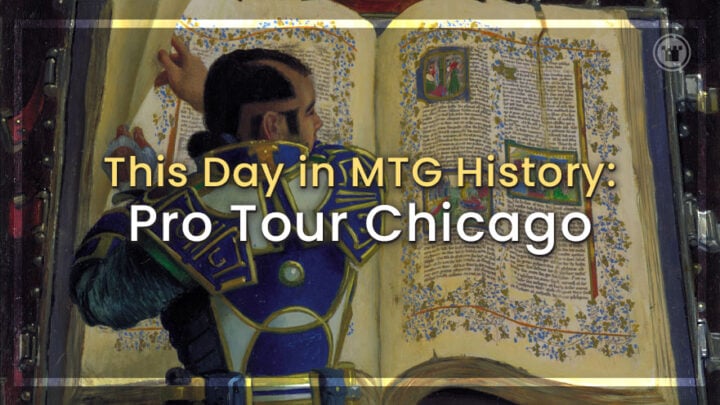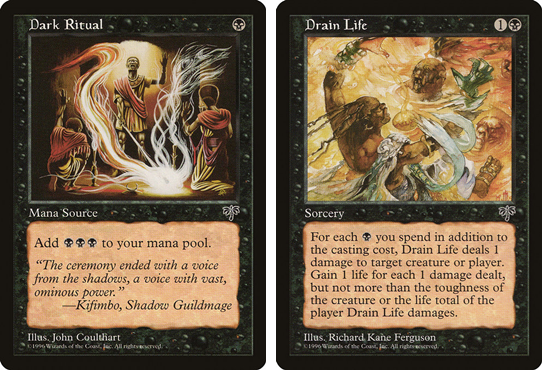Welcome to another edition of “This Day in Magic History.” Today, we’ll be taking a look at a piece of Magic’s competitive history: Pro Tour Chicago.
The event ran from Oct. 10-12, 1997, and it matters more than most because it was the very first Pro Tour for the Extended format. As a result, it was largely dominated by the now infamously overpowered Necropotence.
In this article, we’ll take a brief look at the creation of the Extended format and the Necropotence decks that made their debut at this event.
The Creation of Extended
The creation of Extended was actually covered in-depth in an earlier edition of this series, so I’m not going to spend too much time on it here. Suffice it to say, it was created in July of 1997 as a middle ground between the Eternal formats and Standard.
This middle ground was necessary because the other formats had problems. The Eternal formats, for example, had a really difficult barrier of entry. Even in 1997, older cards were incredibly expensive and hard to come by!
Meanwhile, the fact Standard rotated so much made some players wonder why it was even worth it to build decks for the format in the first place.
The Extended format addressed both of these issues. While Extended rotated, it did so much less frequently. Generally, your Extended decks would be legal for a few years.
Additionally, it didn’t go back so far that it was necessary for you to own some of the game’s harder to obtain cards. When the format began, it featured cards from Revised to Weatherlight.
Necropotence and Pro Tour Chicago
Pro Tour Chicago was held about three months after the creation of the Extended format, and in an era before digital Magic, that meant the Pro Tour was the first time people got a chance to see what it would look like.
In one really big way, the format resembled the Standard format of 1996. The very first Necropotence decks emerged in Standard that year, and Necropotence decks also had a big impact on Pro Tour Chicago.
Necropotence is one of the most powerful cards in the history of Magic. It makes you skip your draw step, but in exchange, you can pay one life to exile the top card of your library face down. Then, at the beginning of your next end step, you put that card into your hand. So, basically, it lets you pay life to draw cards.
The Standard versions of Necropotence combined the powerful Enchantment with Dark Ritual and Drain Life. Dark Ritual allowed for a turn one Necropotence, and Drain Life could damage your opponent while also gaining you life so you could draw even more cards. Throughout 1996, Necropotence decks running these three cards dominated Standard.
And uh…the very first Extended Pro Tour was won by Randy Buehler, who ran a deck running these same three cards! While the decks were not entirely identical, the deck’s core was not very different from the Standard decks from a year earlier. Extended was supposed to be a new format, but the deck that defined this Pro Tour didn’t look very new.
Unfortunately, this would go on to be a long-term problem for the Extended format. In fact, when the format met its demise in 2011, it was at least partly because people felt like it was too much like Standard.
The most powerful cards of Standard were often good enough to dominate Extended, too. In 2011, this was true for Jace, the Mind Sculptor and Stoneforge Mystic. I have covered the demise of Extended in this series too, if you want to know more.
The Rise of Randy Buehler
Pro Tour Chicago was Buehler’s first Pro Tour, and he just happened to win the whole thing with his Necropotence deck. This launched the career of one of the most successful Magic players of all time, and he has of course also gone on to be an important personality.
His success at Pro Tour Chicago was enough to propel him to winning that season’s Rookie of the Year award. By the time he retired from professional Magic in 1999, he had added 7 Grand Prix Top 8s to his resume. He retired from the game that year because he landed a job at Wizards of the Coast, where he would go on to be involved in the design of over a dozen sets, including Invasion, Odyssey and Onslaught. He left Wizards of the Coast in 2004, but he later became one of the main broadcasters for professional Magic tournaments until 2016. Unsurprisingly, Buehler was elected to the Magic Hall of Fame in 2007.
That will do it for this edition of This Day in Magic History! I will be back next week to discuss another important event in the history of our favorite game.

Jacob has been playing Magic for the better part of 24 years, and he especially loves playing Magic’s Limited formats. He also holds a PhD in history from the University of Oklahoma. In 2015, he started his YouTube channel, “Nizzahon Magic,” where he combines his interests with many videos covering Magic’s competitive history. When he’s not playing Magic or making Magic content, he can be found teaching college-level history courses or caring for a menagerie of pets with his wife.



